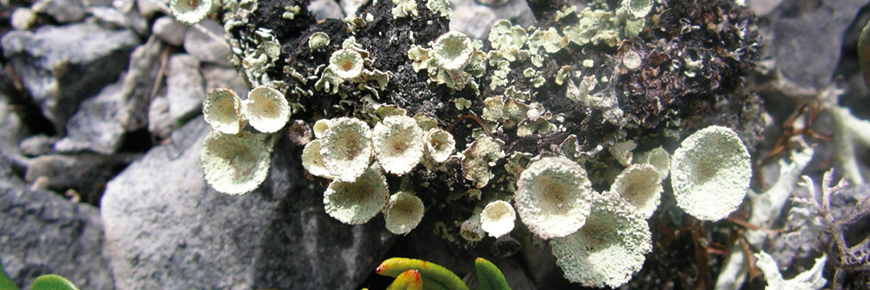
Lichens
Mingan Archipelago National Park Reserve
More than 190 lichen species have been listed in the Mingan Archipelago National Park Reserve, but there are still several species to inventory. They are particularly abundant in lichen barrens and in the transitional zones from the boreal forest to the maritime forest tundra and from the barren to the shoreline, forming spruce–moss stands characterized by conifers and scattered shrubs and thick covers of lichens on the ground.
Lichens are formed from fungi living in symbiosis with green algae and/or cyanobacteria (photobionts). Photobionts share the sugars produced during photosynthesis with the fungi, and in the return, the fungi share the mineral salts and moisture taken from the surrounding air. Since lichens do not have roots, they are very dependent on the conditions of the ambient air and air particles, which makes them very sensitive to air pollution.
Boreal forest

One of the most obvious manifestations of the boreal maritime climate in the Mingan Archipelago is the abundance of corticolous lichens hanging from the branches of the conifers found on the islands. Among these, there are several species of hairy lichens such as Old-man's Beard forming large epiphytic filaments distinctive of mature boreal forests. The presence of these lichens is a good indicator of clean air, several animals also use it to build their nests or shelters. Other hairy and leafy lichens such as the Giant Clad lichen and the Common Freckle Pelt lichen can be seen on moss covered ground.

Lichens are pioneering, slow-growing organisms, capable of accumulating good amounts of water in times of abundance and withstanding desiccation in drier periods. This adaptation, combined with a great ability to survive significant temperature variations, allows them to predominate in several boreal and subarctic environments. They are also an important food source for several species of animals living in northern regions, including caribou, black bear and moose.
Barrens

Like bryophytes, lichens have an important ecological role in the creation of soil. Their colonization and alteration of the rock allows the accumulation of organic matter. Lichens in the Mingan Archipelago National Park Reserve are particularly vulnerable to climate change and the loss of habitat caused by the invasion of more competitive vascular plant species.

Lichen tundra, maritime forest tundras and ombrotrophic peat bogs of the islands in the park reserve consist mainly of "Reindeer lichen", a general term used to designate several species of fruticulous lichens covering the ground such as the Cladina Stellaris and the Gray Reindeer lichen. It is actually very interesting to follow the successions of lichen stands in the barrens. The encrusting lichens first colonize the limestone rocks of the rocky barren, then they are replaced by small leafy lichens, which in turn are dislodged by fruticulous lichens.
Shoreline

Closer to the sea, it is possible to observe leafy lichens like the Elegant Sunburst lichen growing as orange rosettes on the exposed summits of monoliths and rocks of the high barrier. It is a very hardy species capable of photosynthesis down to -24°C (-11.2°F) and obtaining its nutrients from seabird guano. The Dark Green Speck lichen is an encrusting lichen which is also found in this environment, forming thin layers on the cliffs exposed to the spray.
Related links
- Date modified :